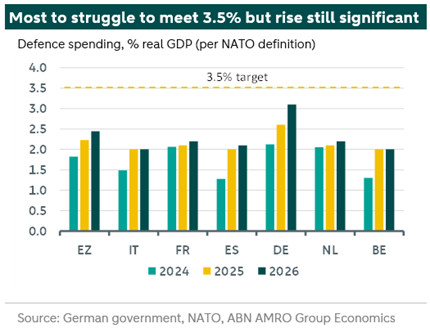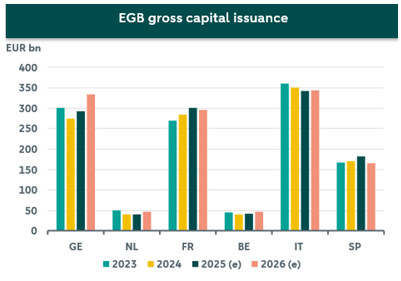NATO Summit - Defence spending to still rise significantly, even if 3.5% is unrealistic

NATO leaders today voted to officially raise the alliance’s defence spending target to 5% of GDP from 2% previously, comprised of 3.5% in core defence spending (the figure directly comparable to the previous 2% target) and 1.5% in infrastructure related to defence. With many countries likely to have already met the latter target, the really important number is the 3.5%, and it is here where there are major doubts over both the willingness but also the capability of meeting this target. Spain has a vague exemption from the target, while other countries openly doubted the target in the run up to the Summit.
Even before opposition to the target became apparent, we also took the view that many countries lacked either the political urgency, or the fiscal capacity, to raise defence spending to such a degree (see our note from March). For instance, France and the UK would like to spend, but are in a fiscally very difficult position, and will struggle to raise spending without making politically sensitive spending cuts or tax rises. Others such as Spain and Italy also lack fiscal space, but also do not see the same political urgency to spend (as is clear from a recent commissioned by the ECFR).
The target is set to be reached over a 10 year time horizon, with countries to submit “annual plans showing a credible, incremental path to reach this goal,” and “spending under this plan will be reviewed in 2029, in light of the strategic environment and updated Capability Targets.” The long time horizon and use of the term ‘incremental’ – combined with the interim 2029 review – clearly gives maximum leeway for the target to be met, and this leeway was likely instrumental in getting all countries on board. All of this adds to our conviction that really big rises in defence spending will be confined chiefly to Germany.
…but spending still set to rise significantly
Although the 3.5% target is clearly unrealistic for most countries, European countries are still set to dramatically raise spending already this year. According to comments today by NATO Secretary General Rutte, countries that have long lagged the 2% target are now set to reach that target in the coming year. This implies significant rises in spending in laggards like Spain, Belgium (which both spent just 1.3% of GDP in 2024) and Italy (1.5% in 2024), while according to the budget announcement yesterday, Germany looks set to raise defence spending to north of 3% of GDP by 2027, with the 3.5% goal set to be hit in 2029. All told, eurozone aggregate defence spending is expected to rise from 1.8% in 2024 to 2.5% by 2026. As described in our previous analysis on defence spending, the impact of all of this will in the near-term be blunted by the fact that much of it will ‘leak’ outside of the European economy and be spent on imported equipment. However, over time and as European industry adapts to the ramp-up in spending, and a greater share is spent domestically, the positive impulse on growth is likely to increase. We are currently looking closely at the details of the new German budget in particular and will update our forecasts with the next Global Monthly publication released next week.

Recent defence spending sheds light on EGB Supply Outlook
The rise in defence spending is already affecting the supply of German government bonds this year. Yesterday, the Finanzagentur published its issuance outlook for Q3 and increased its borrowing requirement by EUR 19bn (EUR 15bn to be raised via capital market) due to its infrastructure and defence package. This adjustment will bring the total debt issuance to EUR 399bn. We anticipate a high probability that the Q4 outlook will also be revised upward by a similar amount.
The issuance outlook for 2026 should also exceed this year's levels. We forecast an additional borrowing requirement of approximately EUR 50bn to 60bn for next year, assuming all additional spending is managed via debt and not through cost-cutting measures elsewhere. Our estimate for the defence spending incorporates the 3.5% target by 2029 communicated by the German government, which suggests an additional EUR 20bn in spending necessary per year to achieve this target in a linear manner. The infrastructure plan will further add around EUR 40bn, as it aims for EUR 500bn over the next 12 years.
For the other big-6 countries, our supply outlook is relatively modest compared to Germany. As discussed above, not all countries have set targets as ambitious as Germany and lack the fiscal capacity to do so. Consequently, with ongoing fiscal consolidation in most European countries, a slight increase in defence spending is unlikely to significantly impact the budget balance. Therefore, the financing need will be lower for most countries in 2026, except for Belgium and the Netherlands as we forecast higher deficits (and higher redemption for Netherlands in 2026).

What does that mean for EUR rates outright?
German government bonds underperformed compared to the rest of the EGB market as risk sentiment improved following the ceasefire in the Middle East, shifting focus back to fiscal matters. The sell-off was most pronounced in the 30y part of the curve, partly influenced by speculation that the debt agency might consider issuing a 50y bond. However, this has not been officially confirmed by the Finanzagentur and we doubt it will see light anytime soon.
Overall, this situation supports our view that the yield curve will steepen further as we approach 2026. The term premium is expected to continue rising gradually as the bund free float normalizes further as supply keeps on rising and demand shifts more and more in the hand of price-sensitive investors. This will exert upward pressure on the longer end of the curve, particularly in the 10y-30y part of the curve, while the short end remains anchored to the policy rate.
However, bund yields could still benefit from a flight-to-quality as geopolitical tensions remain high and potential renewed trade tensions with the US loom, especially as we approach the July 9th deadline with no deals made with the EU. This scenario could prompt additional repricing of rate cuts by the market, as tariffs would have negative impacts on the Eurozone economy.

